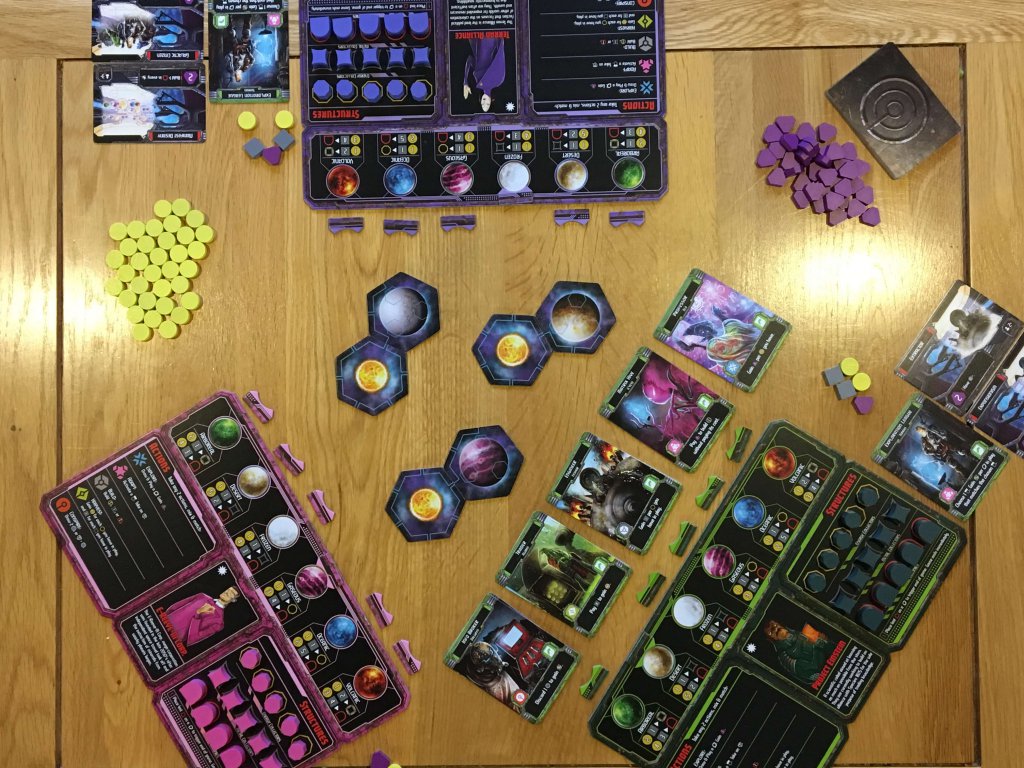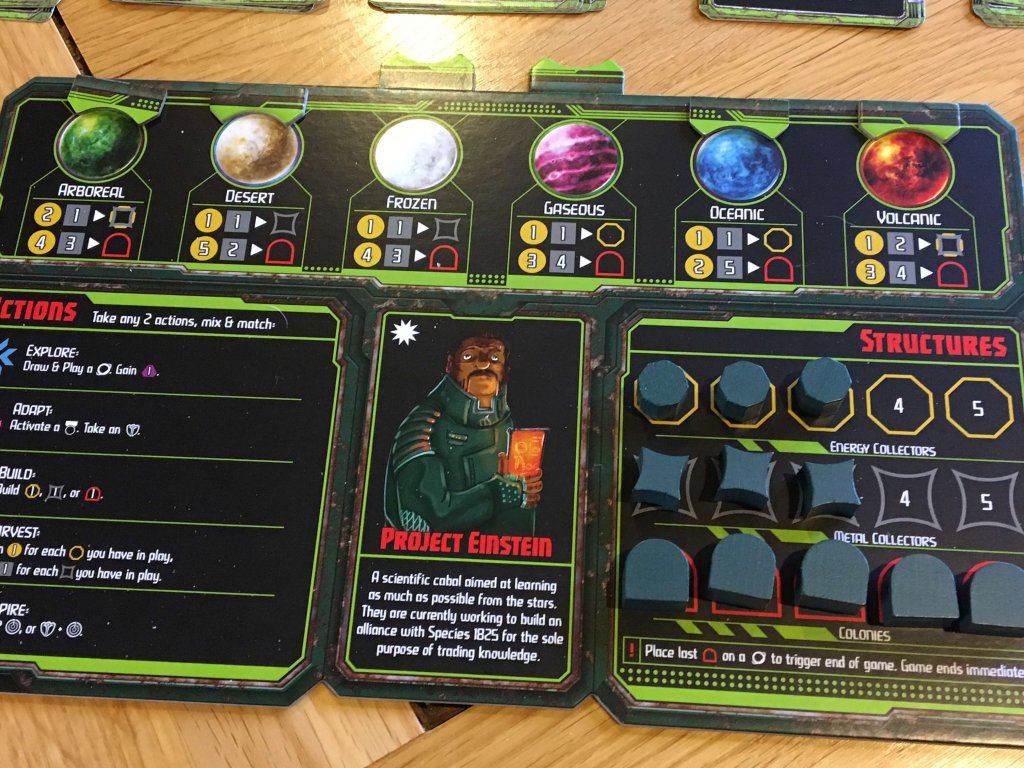Horizons — To boldly go
![]()
-
Have you ever dreamed of travelling through the stars, exploring new worlds and exploiting their resources to fuel the expansion of your species? Horizons is certainly not the first board game to help this dream materialise, but it is one of the most straightforward to set up and play. Where similar spacefaring games tend to focus on intrigue, combat and politics between races, Horizons is more about resource management and area control, with personality introduced via recruitable ally cards.
At the beginning of the game, the players each take a player board and decide to play with either the standard ‘human’ side or the alternative ‘alien’ side. Human player boards all share the same ability, whilst the aliens each have a unique special ability which introduces a tiny bit more complexity to the game, as well as a fair amount of additional replay value through asymmetry. The main play area is entirely modular and made up of one hex-shaped star tile plus a starting planet for each player. Players will expand any of these star systems as the game goes on, with none of them inherently belonging to any individual player.
Horizons is more or less a straight victory-point collection game, with the measure of success being Knowledge. Some of the functions in the game mean players can gain or lose knowledge, so there are occasions when a player may want to sacrifice what is essentially an end-game score to enhance their engine in such a way that they can earn more points over the course of several turns. Mission cards can provide bonus points, but these aren’t made public (or scored) until the end of the game.
As I mentioned earlier, each player has their own player board. On it, they add three rows of five structure tokens, including colonies and resource collectors (for energy or metal). Each player board also demonstrates which kind of planets (ice, lava, desert etc.) a player can build on, thanks to some slightly odd tokens that flip onto the board and kind of look like little docking clamps. I found these fiddly, to be honest, and a cube or similar would have sufficed, but I guess they are in keeping with the overall aesthetic of the game. Above all else, the player boards include a very handy turn summary and several other key bits of information, ensuring that Horizons is very accessible to play.
That said, turns in Horizons are so straightforward that it’s quite hard to lose track of what you want to do. In short, you take two actions on your turn, choosing from the five that are available. After you take each action, you assess the symbol associated with that action and see if it matches one of your ally cards. If it does, you may activate the ability on that ally (if multiple allies have the same symbol, you must choose one) to perform a bonus action. Ally cards enter the play area green side up and flip to their red side when used. Red allies get discarded once used, essentially meaning that unless an effect breaks this rule, each ally has two uses.
Whilst the ally effects vary quite widely from construction or resource bonuses to player interaction (with the separate Extermination mini expansion) the five main actions are always the same. Players can explore, which lets them draw a new planet tile from the bag and add it, either side up, onto one of the existing solar systems that are placed during game setup. They may adapt, which lets player add the little docking clamp piece to a planet type of their choosing and also use the ally abilities I mentioned earlier.
Build is the next action, and whilst it might seem self-explanatory, there are some nuances specific to Horizons. Firstly, players may only build on planets of a type they have adapted to. When building on a planet of any kind, the player will need to look at the information beneath that planet on their player board and pay the amount of energy and metal shown for the building they want to construct. For example, it might cost one player two metal and two energy to build on an ice planet, but it might cost someone else three energy to build the same. This is one of the most interesting areas of asymmetry in Horizons, since it drives demand for planets of different kinds and informs player choice when choosing which side of an explored planet to place.
With buildings in place, the next action is to collect resources, which essentially activates all of the resource-collection buildings that player has already built. In doing so, they will collect energy and metal for later use. Finally, players can take the Conspire action, which lets them draw two mission cards, or one mission and one ally card. Players can hold a maximum of five allies and five mission cards, meaning that having four to five completed missions at the end of the game tends to be optimal.
Given that the focus of Horizons is purely on gathering knowledge, it’s worth noting the ways in which you can do so. Firstly, players can explore. After that, the means for obtaining further knowledge will generally come from either completing missions or using the abilities offered by allies. Small engines that generate resources and turn them into knowledge can be built, for example, but the fact that allies will always flip and then disappear after their first and second use respectively ensures that there is no way (that I’ve seen) to abuse this system.
When the last colony is placed, the game ends and you add gathered knowledge to completed mission scores. Then you add a bonus for area control based on the number of structures in a star system. The player who has amassed the most total knowledge is the winner, and each game of Horizons will usually last about an hour to ninety minutes. This is not a game that tends to run well over that timeframe simply because the choices a player can (or will want to) make are fairly linear and whilst chaining actions can be beneficial, it’s always fairly transparent.
Playing Horizons is a pleasant experience in that it feels a lot like a 4X (explore, expand, exploit, exterminate) game, but without the extermination. Funnily enough, the Exterminate add-on I mentioned earlier is probably titled that way on purpose, since it does allow players to choose allies that do bad things to other players. I love that Horizons has this kind of interaction available immediately, but that it comes as a variant rather than in the base game. It’s probably implausible that up to four races vying for the same resource and planets in this way wouldn’t wage war, but putting that thematic wobble aside, the base game is much more welcoming to newcomers and younger players than a traditional 4X title would be.
Overall, with its excellent looks and high component quality, Horizons looks very appealing on the table. The large player boards and ever-expanding system of planets never fails to catch the attention of a passing gamer, and all of the ally artwork is detailed and luxurious to look at. Gameplay is simple to learn and fast and fun to play, meaning that I really did enjoy my time with Horizons.
If there was a catch to all this praise, I’d possibly suggest that Horizons doesn’t have the depth that some of the people I play with are looking for, which means that it won’t have the playtime I think it deserves. For many players, however, a time-boxed, one-hour-long experience that offers a strong dose of 4X flavour might be just the ticket. If that sounds like you, don’t hesitate to add Horizons to your collection.
A copy of Horizons was provided for review purposes. You can find out more about it on the website of publisher Daily Magic Games.
Love board games? Check out our list of the top board games we’ve reviewed.





Comments are closed.